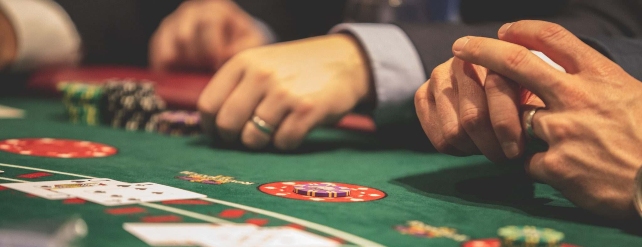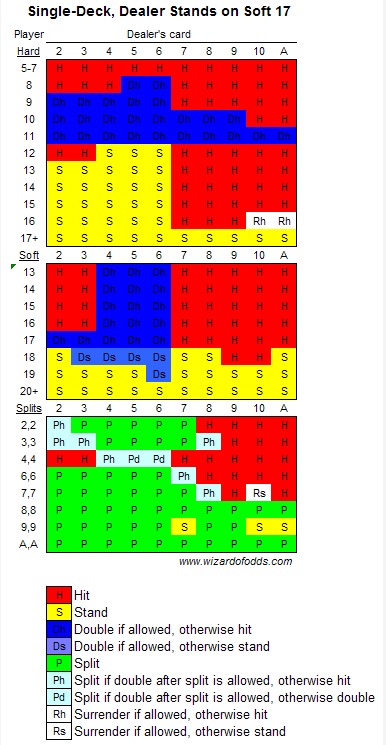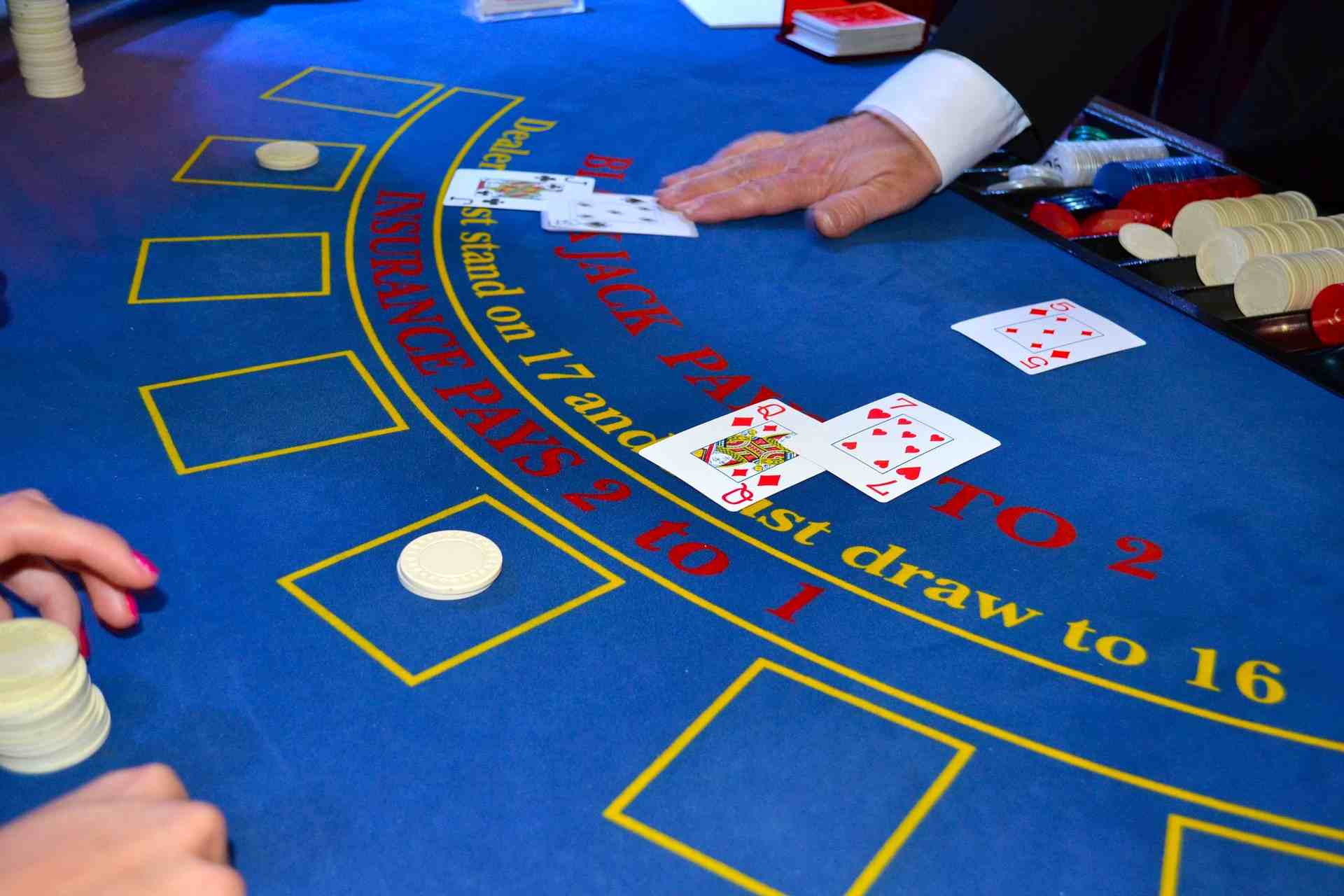
Blackjack Chart For Basic Strategy
Blackjack players which are relatively new to playing (online) blackjack are oftentimes looking to learn the correct blackjack strategy. In these cases, it is most common to, first of all, refer to Blackjack basic strategy since an optimal strategy would also include a card counting system (and more). And therefore require Blackjack strategies which would be pretty advanced already and take time to get built up. This will not be the prerogative of this following Blackjack chart article. Moreover, we will be looking into the type of Blackjack strategy chart which was made for basic Blackjack strategy only.
It is absolutely necessary also to mention right away that rule variations and also the number of decks (single deck games, double deck, multi-deck game, etc.) have an effect on the needed Blackjack strategy. Blackjack charts can be very helpful in order to reduce the house edge in an online casino by quite an increment. At the same time, they are absolutely not a guarantee to automatically beat the dealer’s hand. They are more guidelines, call them playing strategies, which can result in a winning hand by a higher chance. Especially in terms of earning more money or playing the best Blackjack strategies, this type of basic Blackjack strategy will not lay out the one “correct” strategy. After this has been settled, we can start our article.
What a Blackjack Cheat Sheet is Good for
Now, we all know that card games are as much a game of luck as any other given game in (online) casinos. When compared to online slots though, for example, it becomes clear that there is no actual influence a player can have on the result of his gaming round. The Random Number Generator will always only lead towards randomized outcomes. Blackjack games, on the other hand, come with the opportunity to reduce the ongoingly established house edge.
As we are assumingly not already dealing with card counters among our readers, basic Blackjack strategy charts are the mere beginning of what professional Blackjack strategies could eventually develop towards. Obviously, the goal of a Blackjack chart is all about beating the dealer. Under the most likely circumstances and by memorizing a specific pattern of how to act in the very special Blackjack game situation.
Millions of millions of operations on playing Blackjack were carried out by computers to craft these Blackjack strategy cards. Meaning that this playing strategy is based on several million different player hands and dealer upcards. Calculating from every possible combination to every possible failure and to every possible success, a “correct” basic strategy is accordingly eager on presenting a Blackjack strategy where the you-lose-money-scenario is minimized as time goes by.
Blackjack Basic Strategy Chart: Short History
The history of finding a basic strategy for Blackjack games already dates back to the 50s and 60s of the 20th century. The U.S. Army engineers, also known as the Four Horsemen of the Apocalypse, Roger Baldwin, Wilbert Cantey, Herbert Maisel, and James McDermott made this first foray. Basically thereby forming a card counting strategy and moreover the first-ever fundamentally laid out card counting system which nevertheless never came to be a positive-expectation one at that.
Edward O. Thorp was smitten by these findings and gave himself the task to test them on IBM high-speed computers where he substantialized them for the most part. Thorp also used to formulate his own counting systems which he even put into the implementation phase in many casinos across Las Vegas. Thorp’s work Beat The Dealer dating from the year 1962 is furthermore considered as one of the ground-breaking works on Blackjack strategy.
Following generations would take these (practical) theories as the foundation for shaping them further both by using more enhanced computers but likewise by playing strategy at actual Blackjack games. The MIT Blackjack groups of the 1990s are a prime example in this case. As is Stanford Wong decades earlier.
Basic Blackjack Chart: An Example

Accounting for a single deck game or multi-deck games and also Blackjack variations, Blackjack charts differ naturally. For the sake of keeping it simple, we will turn towards single deck game Blackjack strategy charts including the scenario where the dealer stands on soft 17 on the Blackjack table. For the Blackjack strategy, there are a couple of prime parameters which should be clear first-hand.
Blackjack Chart with Surrender
Given the circumstance, that the online casino you are playing your Blackjack game at, has the option to surrender this will be your first question. You have to keep in mind though that surrendering is only possible on the original bet in combination with the first two cards dealt into your hand. As soon as you hit another card, there will be no way to surrender anymore, so surrendering is at all times the first head-cracker (if applicable).
When to Split in Blackjack Chart
Next you will be asking yourself if you should split your hand. Including the important notion if you should split aces. Obviously, this is only substantial in case you have a pair or two ten-valued cards (10, Jack, Queen, or King) available.
When to Double Down in Blackjack Chart
For most Blackjack games, it is a really good sign when a chart tells you to double down within a specific context. This indicates that your chances of winning the hand are outright excellent! A basic strategy would not recommend doubling down without the background of a high probability of leading to a successful outcome.
Blackjack Hit or Stand Chart
In the end, it all comes down to the predicament if you should hit or stand while you play Blackjack. After the dealer deals your first two cards and you cannot decide for any of the above strategy patterns, then only hitting or standing remains as the options. Strategy charts can be valuable here since they give you an idea of what is to be done in order to collect your winnings.
Don’ts of Basic Strategy
Something which should be clear is the underlying factor that an insurance bet or even money should not be taken. All the rules of basic Blackjack strategies hint towards this since only a “perfect Blackjack strategy” with card counting included would strategize for the best moment to take this side bet.
How to read a Betting Strategy
In order of properly reading a Blackjack chart, there is not much of a fuss you have to do:
- The dealer’s upcard is shown on the top-line horizontally of the Blackjack chart
- On the left side of the chart, you will find the player’s hand
- Hands with a value lower than 9 are commonly prone to hit another card
- Common sense for a ten-valued card is to double down
- Pairs should be split to increase winning chances
- Split Aces to beat Blackjack (hit 21)
- Stand on A,9 or higher (soft total)
Something we just mentioned here and which might need further explanation is the difference between soft total and hard total. A soft total is a Blackjack hand that has an ace as part of the first two cards dealt. Meaning that the ace starts to count as 11. A hard total on the other hand does not include an ace within the first two cards. Furthermore, an ace only counted as a 1 instead of 11 while you play blackjack contributes to a hard total.
Blackjack Chart Single Deck: Dealer Stands on Soft 17

In a single deck game of Blackjack where the dealer does not hit soft 17 but stands on it, you should really never take an insurance bet. Taking an insurance bet means that under the circumstance that a dealer has an ace as an upcard, you sacrifice half your bet if the dealer hits Blackjack. Not only for single-deck Blackjack an insurance bet favors the house edge to quite a degree. The same goes for even money. The playing strategy is:
- Surrender (if possible) with a hard total of 16 vs. dealer’s upcard 10 to Ace
- Hit another card on 5-7 hard total in any case
- Always split aces and 8s
- Split 9s on upcard 2-6 and 8-9, otherwise stand
- Split 7s on upcard 2-7, split on 8 and 10 if double down is allowed, and hit otherwise
- Split 6,6 on upcard 2-6 and hit otherwise
- Hit 4s unless the dealer’s up card is 4-6 and double down is allowed after a split
- Split 3s on upcard 4-7, otherwise hit
- Split 2s on upcard 3-7, otherwise hit
- Double down on 10 (vs. dealer’s upcard 2-9) and 11 (in general)
- 17 and more always stands on hard totals
- 16 stands vs. dealer’s up card 2-6, otherwise hit
- 15 stands vs dealer’s upcard 2-6, otherwise hit
- 14 stands vs. dealer’s up card 2-6, in other cases hit
- 13 stands vs. dealer’s upcard 2-6, otherwise hit
- 12 stands dealer’s upcard 4-6, if above or lower hit
- 9 doubles down vs. up card 2-6, whenever above hit
- 8 doubles down vs. dealer’s card 5-6, if lower or above hit
- Soft 20 (A,9) always stands
- Soft 19 (A,8) stands against dealer unless the upcard is 6
- Soft 18 (A,7) doubles against dealer 3-6, stands on 2, 7-8, and A as well as hits on 9-10
- Soft 17 (A,6) doubles against dealer 2-6 and hits 7-A
- Soft 16 (A,5) doubles down against dealer 4-6, in any other case hits
- Soft 15 (A,4) doubles down against dealer 4-6, in any other case hits
- Soft 14 (A,3) doubles down against dealer 4-6, in any other case hits
- Soft 13 (A,2) doubles down against dealer 4-6, in any other case hits

Conclusion: Memorize the Strategy Chart
We have decided to go for the scenario with single-deck games for good reasons here. After all, we want to make an introduction to a basic type of Blackjack game for rather inexperienced players. Obviously, it is best if you study the respective Blackjack chart as much as you can before you play Blackjack. For a way more advanced, “perfect” Blackjack strategy you will have to learn a lot more about Blackjack variants since according to the number of decks and regions, these card games do not have the same rules.
Counting cards is another deeply investing strategy that can be very helpful in most casinos. In any case, it is the best approach though to memorize charts and learn basic Blackjack strategies in order of having simple access to the multi-deck game version, Las Vegas rules, and so on. With our article, you are doing the first step to what can be successively elaborated into the best Blackjack strategies available!
Blackjack Chart FAQ
When should I double down according to the Blackjack chart?
When speaking of a single-deck Blackjack game where the dealer stands at soft 17, you should definitely double down on most 10 and all 11 hard totals. Concerning soft totals, you should double down with a soft 17 (A,6) vs. dealer’s upcard 2-6 and soft 13-16 against the dealer’s card 4-6.
When should I split related to the Blackjack chart?
The rule of thumb says that you should clearly split aces and 8s. 6s only vs. 2-6, 7s vs. 2-7, 2s vs. 3-7, 3s vs. 4-7, and 9s vs. 2-6 as well as 8-9.
What is the difference between a basic Blackjack chart and a perfect strategy Blackjack chart?
The Blackjack chart in itself does not account for much of a difference. After all the combinations are based on, either way, pre-existing rules. Perfect strategies which can also be coined optimal strategies are merely more than words used for phrasing strategies for Blackjack. Charts have to be supported by specific skills such as counting cards, knowing about deviations, and more in order to truly establish advanced strategic patterns.
Are there interesting movies about counting cards?
If you are in the mood for a movie about counting cards at Blackjack, you should try to watch The Card Counter (2021). This movie follows many character motivations but among them you will for instance come upon the “Card Counting legal” question and some rather melancholic inner monologue background info around the popular card game.


